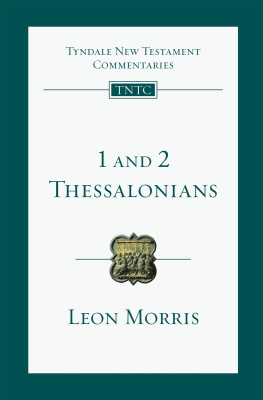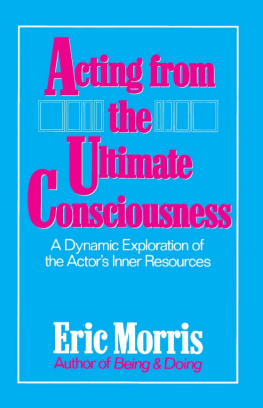TYNDALE NEW TESTAMENT
COMMENTARIES
VOLUME 13
1 AND 2 THESSALONIANS
InterVarsity Press, USA
P.O. Box 1400
Downers Grove, IL 60515-1426, USA
World Wide Web: www.ivpress.com
Email: email@ivpress.com
Leon Morris 1984
All rights reserved. No part of this publication may be reproduced, stored in a retrieval system or transmitted in any form or by any means, electronic, mechanical, photocopying, recording or otherwise, without the prior permission of Inter-Varsity Press.
InterVarsity Press, USA, is the book-publishing division of InterVarsity Christian Fellowship/USA and a member movement of the International Fellowship of Evangelical Students.
All Scripture quotations, unless otherwise indicated, are taken from the Holy Bible, New International Version. NIV. Copyright 1973, 1978, 1984 by International Bible Society. Used by permission of Hodder and Stoughton Ltd. All rights reserved. NIV is a registered trademark of International Bible Society. UK trademark number 1448790. Distributed in North America by permission of Zondervan Publishing House.
First edition 1956
Second edition 1985
ISBN 978-0-8308-9490-1 (digital)
ISBN 978-0-8308-4243-8 (print)
This digital document has been produced by Nord Compo.
TYNDALE NEW TESTAMENT
COMMENTARIES
VOLUME 13
GENERAL EDITOR: LEON MORRIS
1 AND 2 THESSALONIANS
AN INTRODUCTION AND COMMENTARY
LEON MORRIS

General preface
The original Tyndale Commentaries aimed at providing help for the general reader of the Bible. They concentrated on the meaning of the text without going into scholarly technicalities. They sought to avoidthe extremes of being unduly technical or unhelpfully brief . Most who have used the books agree that there has been a fair measure of success in reaching that aim.
Times, however, change. A series that has served so well for so long is perhaps not quite as relevant as when it was rst launched. New knowledge has come to light. The discussion of critical questions has moved on. Bible-reading habits have changed. When the original series was commenced it could be presumed that most readers used the Authorized Version and one could make ones comments accordingly, but this situation no longer obtains.
The decision to revise and update the whole series was not reached lightly, but in the end it was thought that this is what is required in the present situation. There are new needs, and they will be better served by new books or by a thorough updating of the old books. The aims of the original series remain. The new commentaries are neither minuscule nor unduly long. They are exegetical rather than homiletic. They do not discuss all the critical questions, but none is written without an awareness of the problems that engage the attention of New Testament scholars. Where it is felt that formal consideration should be given to such questions, they are discussed in the Introduction and sometimes in Additional notes.
But the main thrust of these commentaries is not critical. These books are written to help the non-technical reader to understand his Bible better. They do not presume a knowledge of Greek, and all Greek words discussed are transliterated; but the authors have the Greek text before them and their comments are made on the basis of the originals. The authors are free to choose their own modern translation, but are asked to bear in mind the variety of translations in current use.
The new series of Tyndale Commentaries goes forth, as the former series did, in the hope that God will graciously use these books to help the general reader to understand as fully and clearly as possible the meaning of the New Testament.
Leon Morris
Authors preface to the first edition
The epistles to the Thessalonians are all too little studied today. It may be true that they lack the theological profundity of Romans and the exciting controversy of Galatians; but nevertheless their place in Scripture is an important one. No other writing of the great apostle provides a greater insight into his missionary methods and message. Here we see Paul the missionary and Paul the pastor, faithfully proclaiming the gospel of God, concerned for the welfare of his converts, scolding them, praising them, guiding them, exhorting them, teaching them; thrilled with their progress, disappointed with their slowness. Though the continuous exposition of great doctrines is not a characteristic of the Thessalonian writings, yet it is fascinating to see how most, if not all, of the great Pauline doctrines are present, either by implication or direct mention. When we consider the undoubtedly early date of these letters this is a fact of importance in the history of Christian thought.
Especially important is the teaching of these epistles on eschatology; and in view of the revival of interest in this doctrine in recent times it is imperative that we understand and appreciate the contribution of Thessalonians to this difcult subject. It is my earnest hope that this short commentary may help to direct the attention of Christian people to the importance of these epistles and the relevance of their message for the men of today.
Every commentator, I suppose, bases his work on that of his predecessors, and in this I am certainly no exception. I have learned much from those who have written on these epistles before me, and cannot hope to have acknowledged all my indebtednesses. I have found particularly helpful the commentaries by Milligan, Frame (I.C.C.), Denney (Expositors Bible), Findlay (who wrote two commentaries, one in the Cambridge Bible for Schools and Colleges, and the other in the Cambridge Greek Testament series), and Neil (Moffatt New Testament Commentary), while Lightfoots Notes on Epistles of St Paul is a veritable treasure house.
Finally may I express my indebtedness to a number of my friends who have interested themselves in this project and made helpful suggestions. Especially am I indebted to the Very Rev. Dr S. Barton Babbage, the Rev. David Livingstone, and Mr I. Siggins, who read the typescript, and suggested many improvements.
Leon Morris
Authors preface to the second edition
In the years since this commentary rst appeared there have been some notable contributions to the literature on these epistles, particularly the great commentaries by Rigaux in French and Best in English. I am grateful to both, and also to those who produced smaller commentaries, such as Ward, Moore, Whiteley and Bruce. These and others have been a great help to me as I worked over the material again. I have indicated my principal indebtednesses in the footnotes.
The revision has also enabled me to rewrite the whole and there are many minor verbal alterations. Some things have been omitted as being of less importance now than in 1956 and this has given me space to include new material. Substantially this is the commentary I wrote in the 1950s, but I trust improved by what I have learned from the scholars I have mentioned and others. The English version used is the New International Version. I trust that in this new form this little book will prove useful to another generation of readers.



















